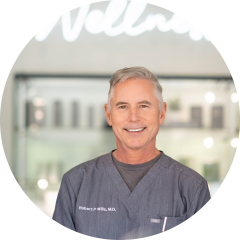What is Aging? Why do we age? The aging process consists of a constellation of progressive, degenerative, and (seemingly) irreversible transformations that occur at the cellular as we all grow older. If we slow down or thwart this process, we will increase life span. Does this mean we can “treat” aging, or at least certain specific components of aging, as a disease process?
Understand, aging is a natural phenomenon that occurs to everyone. At the cellular and molecular level there are two general theories on aging, and they harken back to the classic “nature versus nurture” debate: (1) aging is programmed in our DNA at birth, i.e., we each have a biological clock that is ticking away, and (2) aging is product of progressive environmental stress at the cellular and chromosomal level. Said differently, aging is thought to be a combination of (1) genetically pre-programmed deleterious cellular changes over time, and (2) oxidative stress on the body leading to injurious and progressive random genetic mutations over time.
Evidence of pre-programmed cell death includes the phenomenon of telomere shortening. Telomeres are “tails” of DNA attached to the end of our chromosomes that act to maintain the integrity of chromosomes, but over time as chromosomes go through their life cycle leading to cell division, telomeres are shortened, leading to the cellular damage and cellular death associated with aging. The enzyme telomerase, which is found in stem cells, repairs and replaces telomeres and thereby is able to delay the “clocking” mechanism that controls the lifespan of dividing cells. In a genotype study performed by Kaiser Permanente on 100,000 middle-aged men and women, looking at 675,000 “snips” of nucleic acids, those individuals with the shortest 10% of telomeres were 23% more likely to die in the three years following telomere measurement. Interestingly, in this study age-matched women also were found to have longer telomeres than men. In a study in mice at Harvard, Ronald A DePinho found that if you stop telomere repair by stopping active telomerase, the mice age. When you switched telomerase back on, after four weeks, atrophied tissue regenerated in several organs, new brain cells developed, and the mice were living longer.
Accidental aging may be thought of as the “wear and tear” theory first introduced in 1182 by Dr. August Weismann, a German biologist. The body and its cells are damaged by use, worn down by toxins in the diet and environment, UV rays of the sun, and the many other physical and emotional stresses to which we subject our bodies. Wear and tear takes place at the cellular level via the body’s loss of ability to repair cellular damage, whether caused by diet and the environment, or by bacteria and viruses. Thus, many elderly people age and die of diseases that they could have resisted when they were younger.
What about free radicals? Free radicals are unbalanced molecules with a free electron and a negative charge, making them highly reactive, and they go on the hunt to seek out balanced molecules in our body from which they can steal an electron in order to attain electrical equilibrium; then they are stable, but have then created a new free radical which sets out on its own quest to snatch an electron. This cycle of atomic pickpocketing leads to cellular destruction, disruption DNA/RNA synthesis, and disruption of protein synthesis. With age, the cumulative effect of free radical damage takes its toll, leading to lipid peroxidation and destruction of cell membranes, formation of age pigments, and the decline of mitochondrial function which leads to a lowering of our metabolism and a host of other potentially harmful effects.
A modern update of the “wear and tear” theory includes neuroendocrine theory of aging. Our neuroendocrine system is a complex network of biochemicals that governs the function and release of hormones and other bioactive proteins. This hormonal system is critical to the ongoing repair and regulation of our bodily functions, and the age-related drop in hormone production leads to a general decline in our body’s ability to repair and regulate itself.
Luckily, many of the biochemical systems in our bodies work on a feedback loop, so careful correction and balancing of hormone and micronutrient levels, and careful management of our levels of chronic inflammation and oxidative stress can get us back on track and possibly delay some of the effects of aging. There are anti-aging strategies for mitochondrial health, telomere health, as well as strategies that address the notion that nutritional supplements and lifestyle changes may help manage the development of free radicals and chronic inflammation, and thereby reverse the aging process and stimulate our body’s ability to maintain and repair its organs and cells.
To find out which state-of-the-art anti-aging therapies might be appropriate for you, please call Westlake Aesthetics & Wellness and get scheduled for an evaluation.
About Dr. Wills
 Dr. Robert Wills is Austin’s leading pain management physician and anesthesiologist, who has served patients in Austin for over 20 years. Westlake Aesthetics & Wellness is a multi-disciplinary practice that offers direct physician supervised leading edge treatment for pain management, wellness and aesthetics. Our wide array of professional services is designed to promote healing and positively impact our patients’ and clients’ lives. Services include but are not limited to: iv infusion, whole-body red light therapy, functional medicine, medical marijuana, laser, aesthetic and cosmetic treatments for hair, face and body. To schedule an appointment, contact us.
Dr. Robert Wills is Austin’s leading pain management physician and anesthesiologist, who has served patients in Austin for over 20 years. Westlake Aesthetics & Wellness is a multi-disciplinary practice that offers direct physician supervised leading edge treatment for pain management, wellness and aesthetics. Our wide array of professional services is designed to promote healing and positively impact our patients’ and clients’ lives. Services include but are not limited to: iv infusion, whole-body red light therapy, functional medicine, medical marijuana, laser, aesthetic and cosmetic treatments for hair, face and body. To schedule an appointment, contact us.

